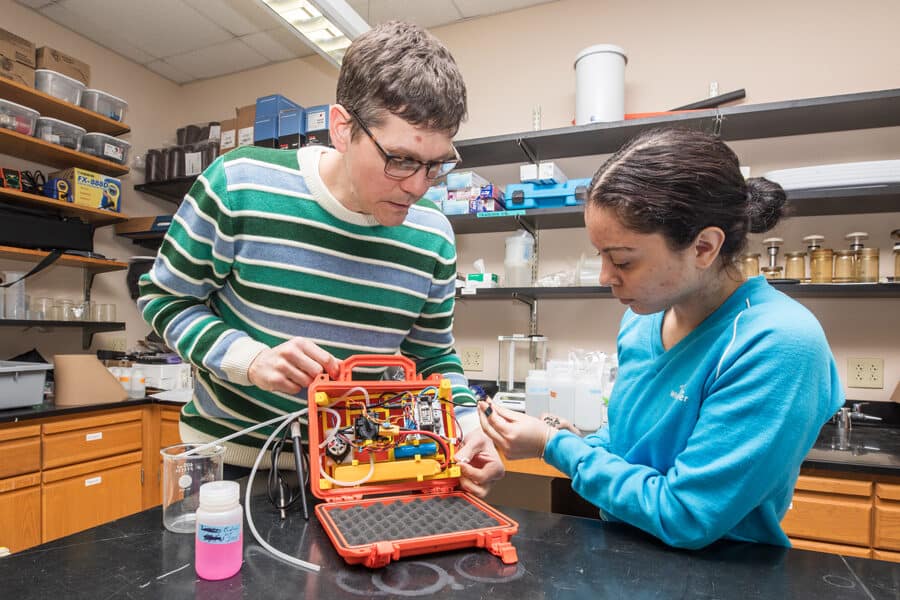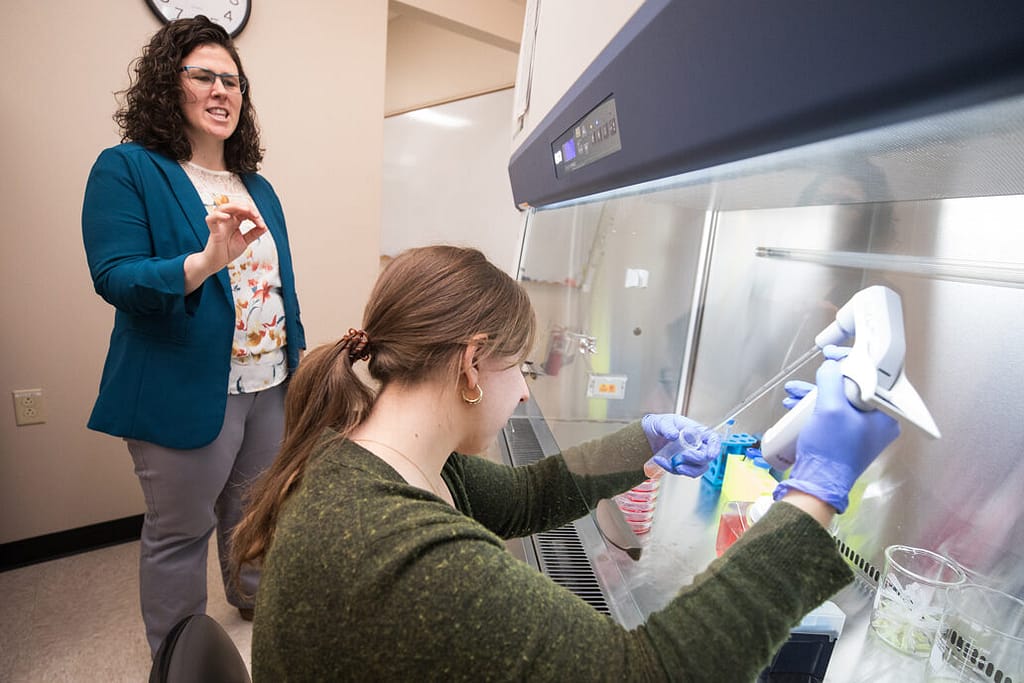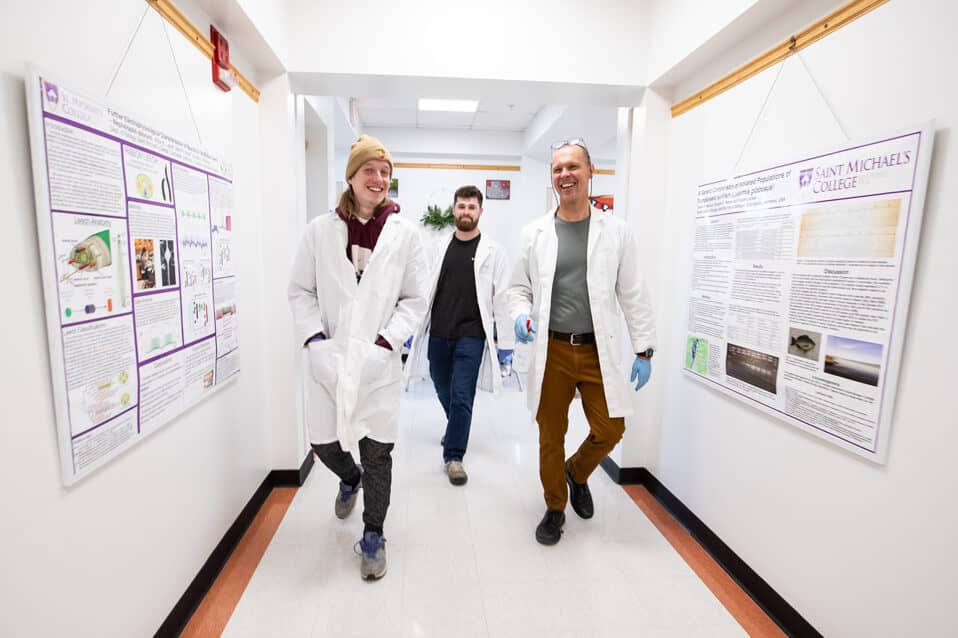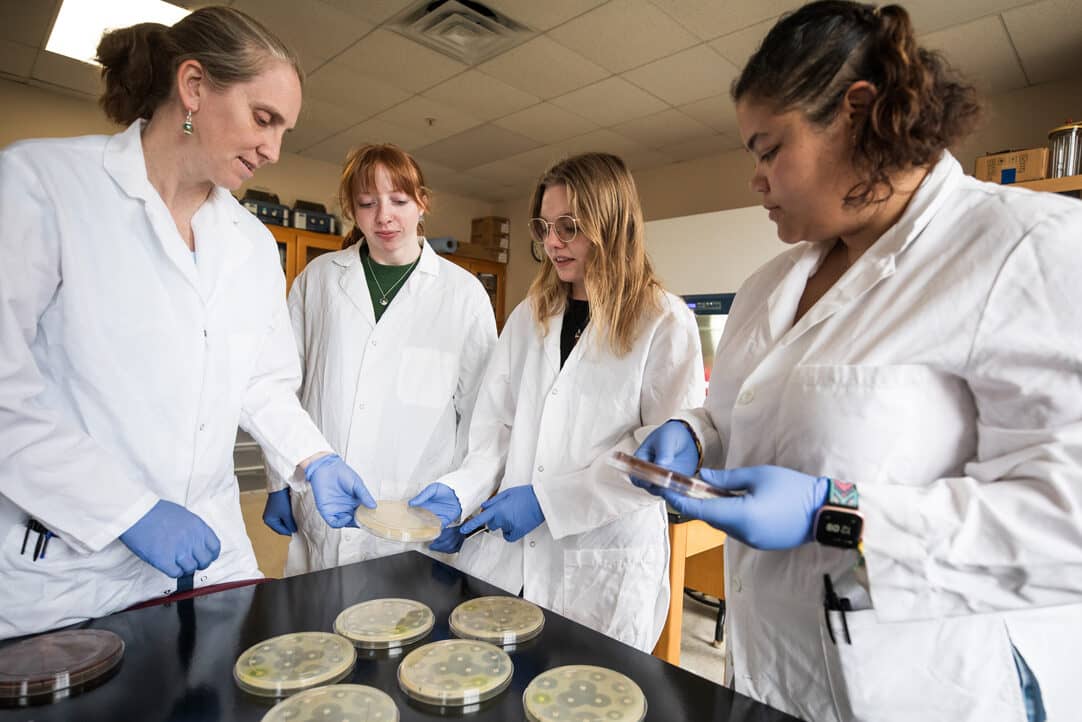Learning by Doing
All across campus, grant funded research projects take on big issues and provide win–win experiences for faculty and students.
Faculty–student collaboration is at the heart of a Saint Michael’s College education. All across campus, grant funded research projects take on big issues and provide win–win experiences for faculty and students. Angela Irvine has been the director of sponsored programs and foundation relations at Saint Michael’s for more than two decades. Irvine serves as the conduit for all grant applications that range from research to projects. The funding Irvine helps secure includes federal and private grants as well as collaborative proposals. Irvine said helping to secure funding for research at Saint Michael’s is personally rewarding for her.
“They’re teaching cutting edge information to undergraduate students,” Irvine said. “Their research has been funded and recognized. They’re bringing that into the classrooms because our faculty are professors first.”
Clay Williams
Assistant Professor of Environmental Studies and Science.
Clay Williams has been working with Saint Michael’s students for several years to help them design their own low-cost algal and cyanobacteria (aka blue-green algae) water quality sensors alongside two teams at the University of Vermont. The group has created something they call the Clarity sensor system. In March, the assistant professor of environmental science helped secure funding for a $25,000 one-year grant from the Vermont-based Lintilhac Foundation. “We’re finally at the point where we have our sensors performing really well in the laboratory. The idea behind it is that we can set these out on swimming beaches,” Williams said.

Photo by Cat Cutillo/Saint Michael’s College
Williams is collaborating with Burlington Parks, Recreation and Waterfront to deploy five sensors into the water in May and monitor for algae blooms along Burlington’s shoreline through November. The sensors will be deployed at Leddy Beach, North Beach, Blodgett. Beach near the Burlington Surf Club, Oakledge’s Blanchard Beach, and in the waters near the ECHO Leahy. Center for Lake Champlain. Williams said algae and cyanobacteria overgrowth and blooms have increased in intensity and frequency since the. industrial and agricultural revolutions, and they have substantial negative economic, recreational, public health, and environmental impacts.
Commercial sensors could cost up to $20,000, whereas the sensors the Saint Michael’s and UVM teams are creating cost $375. Currently, beaches in Burlington are being monitored for cyanobacteria by City employees and volunteers who watch the beaches for visible signs of blooms that would trigger a beach closure. Williams is hoping the new sensors will help collect data before the algae blooms are visible and during off-times, such as at night.
The ultimate aim is to reduce public exposure. “The sensor has a better sensitivity than our eyes do looking for these things. We’re hoping it might give us an earlier detection, or at least more information about what’s causing the blooms, so there could be better ways to stop the blooms in the future,” Williams said.
The recent funding follows prior research and grant funding Williams and his collaborators at UVM received from the United States Geological Survey through the Vermont Water Resources and Lake Studies Center. The earlier funding allowed Saint Michael’s and UVM to pilot the creation of the sensors in the lab and test functionality. This new funding allows Williams and his students to use the sensors in the field. “The students are contributing to a long-term research program for me here. They’re doing things that set up the next opportunity,” Williams said. “Eventually, we can put that material together to tell a better story, to really use it as smaller pieces of a larger vision.”
Lyndsay Avery
Assistant Professor of Biology
Lyndsay Avery is credited with bringing tissue culture to campus by creating a facility that is present at only at three other institutes of higher learning in Vermont. Avery is investigating the human immune system with her students and was awarded a one-year exploratory grant from the Vermont Biomedical Research Network (VBRN) in 2023 for $10,000 to generate pilot data. “It’s a [stepping-stone] to bigger grants,” Avery said. “Hopefully, we’ll get some preliminary data that we can use to apply for more funding.”

Photo by Cat Cutillo/Saint Michael’s College
The assistant professor of biology is an immunologist and a cell biologist who joined St. Mike’s in 2021 and works primarily on T cells. Avery explained that immune cells must be able to migrate all over our body to cure infection. “We saw a single mutation from patients that were having a severe immunodeficiency, and those T cells didn’t seem to be able to migrate well,” Avery said. She explained the mutation is in one protein called Moesin. “My students all have a piece of this project. They are trying to understand how this mutation is affecting some cell biological process,” Avery said.
Avery and her students are investigating whether the mutation affects the development and function of these T cells in the patients with the single mutation. She is working with six research students this semester. Half of the students worked with Avery during the fall semester too, and half are new this spring. She’s paired them together so they can train each other. Avery said the peer mentoring model “breaks down some of the barriers that students have in science” to ask questions.
Lily Sabol ’24 is one of Avery’s lead research students and has been accepted to multiple Ph.D. programs. Sabol will be presenting the group’s work at the Academic Symposium at Saint Michael’s, and in June Avery and Sabol will travel to Washington, D.C., to present at the National IDeA Symposium of Biomedical Research Excellence (NISBRE). “Getting research experience for students is critical, I think, in undergraduate [education]. It absolutely changed my life and what I ended up doing for a career,” Avery said. “If they can get involved early really dive deep into something, explore and learn, and see something for the first time. This isn’t in textbooks because we don’t know the answer. We have to find the answer.”
Avery estimated that since she began in 2021, with the help of grants, alumni donors, and the College, Saint Michael’s has added $300,000 to $400,000 worth of new equipment, including incubators and centrifuges. She noted that the department evengot a brand-new flow cytometer recently. “The students are the center of this work,” Avery said. “They have new ideas all the time, and I just love to harness their thoughts. I enjoy this so much.”
Mark Lubkowitz
Professor of Biology
Professor of Biology Mark Lubkowitz was awarded the 2024 Maize Genetics Leadership Award at March’s Maize Genetics Meeting in North Carolina for his collaboration with students to conduct grant-funded research about leaf angle in corn.

Photo by Cat Cutillo/Saint Michael’s College
Six hundred scientists from all over the world participate in the conference each year. Most of the colleges and universities in attendance are R1 (meaning they have a very high level of research activity) doctoral universities or land-grant institutions. Saint Michael’s is one of very few small liberal arts colleges in attendance each year. Lubkowitz said he can recall only one other person from a small liberal arts college “speaking at this meeting this century.”
Lubkowitz started attending the conference in 1998 and has taken students 75 percent of the time, totaling 30 students over three decades.
This year, Lubkowitz brought Brandon Boris ’24, Emilie Hoffmann ’24, and Kaitlyn Koutsoufis ’24. The trio presented a poster that illustrated the research they had conducted about leaf angle over the summer and how they had identified four switches that contribute to controlling leaf angle. “Their work was validated by global scientists,” Lubkowitz said. “My students were definitely in the limelight. Out of 600 people, there were probably 12 undergraduates there.”
In 2022, Lubkowitz and Valerie Bang-Jensen of the Education Department were awarded a four-year grant for “Genome-Wide Dissection of Leaf Angle Variation Across the Canopy in Maize,” funded through the National Science Foundation as part of the Plant Genome Research Program. The grant runs through 2026 and is a collaborative effort between scientists at Iowa State University, the University of Missouri, Cornell University, and Saint Michael’s College. A total of $2.5 million was awarded for the grant, with $284,000 going to Saint Michael’s.
Lubkowitz and his students have been working on research to manipulate leaf angle so that growers can maximize photosynthesis and minimize competition between plants. The first step is to identify the genes that control leaf angle. “The leaves shade each other,” Lubkowitz explained. “If you change the leaf angle, you’ll get more photosynthesis. If you get more photosynthesis, you get more yield. You get more crop per unit acre. That lowers the cost of food. That lowers the environmental cost of growing food.”
Lubkowitz spoke at the conference and shared his research. He also highlighted how he’s integrated part of his research into his classroom by appointing some students to be researchers in his lab, where he works with them four days a week. “If you learn science by doing science, we’ve created this mechanism by which two-thirds of our students in a given semester are doing a research-basedcurriculum. They’re working on a faculty member’s research project and, hence, learning science by doing science,” Lubkowitz explained.
Boris, who attended the Maize Genetics Meeting this year, has been working in what students affectionately call “The Lub Lab” since last summer. “I believe I played a critical role with my participation in the lab and truly am blessed to be able to be a part of something so amazing,” Boris said. He said being able to work closely with Lubkowitz on his faculty-led research project has been life changing. “I could go on about that man for hours. He makes it fun. I don’t think I would have fallen in love with lab and corn if it wasn’t for him,” Boris said. “He’s one of the most passionate people I’ve ever met.”
Nicole L. Podnecky
Assistant Professor of Biology
Nicole Podnecky never would have guessed working on her high school science fair project would be one of the most formative points in her life. Her project on antibiotic resistance was so convincing, however, that her aunt stopped using antibacterial soap. What’s more, it led Podnecky into an entire career studying antibiotic resistance, which she calls “one of the biggest pressing health issues in the world today.” Podnecky has been an assistant professor of biology in the Public Health Department at Saint Michael’s since 2020. She was awarded $10,000 last year in grant funding from the VBRN to support research on pseudomonas work. Pseudomonas can cause a variety of infections including pneumonia, urinary tract infections, and wound Infections.

Photo by Cat Cutillo/Saint Michael’s College
Some of the grant funding has enabled Podnecky to collaborate with student researchers, with the intent of publishing scientific journals that the students will be coauthors on. “A lot of people don’t leave undergraduate [education] with opportunities to publish,” Podnecky said. She explained that larger universities have graduate students and post-doctoral students already filling research positions that allow for opportunities to publish in scientific journals. At a smaller school like St. Mike’s, there are more opportunities for undergraduates. “We work side by side and train the students to be significant contributors to the research,” Podnecky said. “It’s huge for an undergraduate.”
Last fall, Podnecky began teaching a Biology Communication course, which is required for sophomore Biology majors. In the class, the students learn how to read, write, and organize scientific writing. Podnecky helped them design an experiment testing different fruit juices to see if they had benefits in treating urinary tract infections. The 12 students explored whether the different juices would kill E. coli on a petri plate. They found that cranberry juice has good enhancing effects when it is consumed by a person also taking antibiotics. “When we start doing research, we don’t know what to expect. There’s this excitement,” Podnecky said of her students. “I think sharing that excitement early in their careers is so important to set the stage.”
Podnecky is hoping to publish her class’s findings in a scientific journal this summer that all 12 students will be coauthors on. Podnecky said she hopes the experience of being research assistants and coauthors might inspire some of her undergraduate students to consider careers on the research side. “Now we can get all these students involved in research early in their careers,” Podnecky said. “I hope they find it fun to become experts in this tiny piece of the puzzle.”





